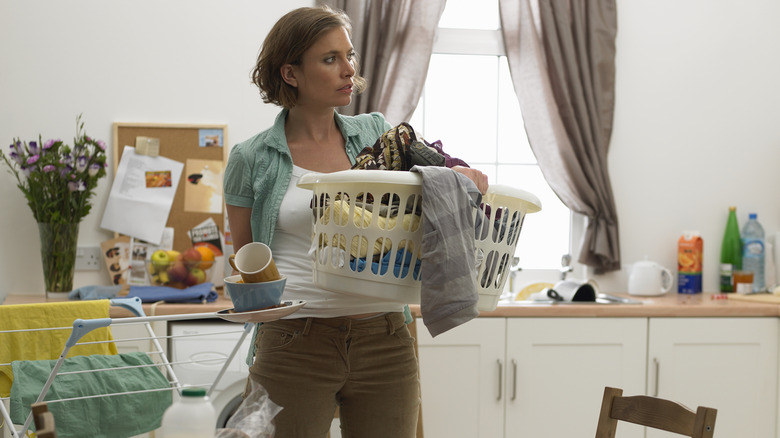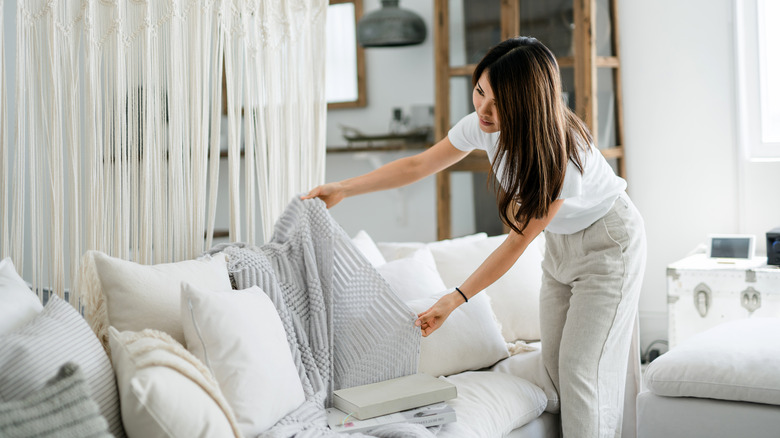TikTok Highlights Why Your Decorating Efforts Always Turn Into Cluttered Catastrophes
Many people get inspired by the homes they see online or in design magazines and try to recreate the look in their own houses. Oftentimes, however, these perfectly-decorated spaces become cluttered soon after, ruining the aesthetic. This is because they are only decorating according to their tastes and not taking into consideration personalization for their lifestyle. Decorating and design enthusiast Julie Sousa says in a TikTok that your decorating efforts always lead to a cluttered catastrophe because you're decorating against your habits. You can make a room feel less cluttered by decorating around established habits rather than trying to force new ones based on your décor choices.
Sousa shows an example of an entryway that has a console table with baskets underneath for dog toys, decorative elements on the tabletop, and a mirror hanging on the wall above. Though this seems like the perfect setup to keep this busy area organized, there's a cluttered pile of shoes in front of the baskets. Sousa goes on to explain that people often decorate first and think of their habits after the fact. In this case, the ignored habit is taking shoes off and leaving them in the entryway. The problem is that there isn't anywhere for the shoes to go, so the well-designed entryway is a disorganized mess. To fix this problem, Sousa recommends choosing a cabinet with closed storage for the dog toys and built-in shelves underneath for shoes, creating a stylish entry that works with the habits and not against them.
Don't rush to decorate
When moving into a new home or redecorating a room, many want to put everything in its place as soon as possible. However, this can become a detriment to the organization of a space. "Pro tip: live in the space a couple of days first, then decorate FOR your habits," Julie Sousa writes in the caption of her TikTok. This is a great rule of thumb for all your functional furniture and décor. Instead of immediately unpacking and decorating, see how you naturally use the space.
Of course, this doesn't mean you should live in a completely empty home for a few days. You can use sofas, beds, and other items you need to live comfortably. But with items meant to organize, such as an entryway table, you should observe your habits before choosing the piece. You should also consider the habits of everyone else living in the home.
In the entryway table example, the solution for adults may be a small cabinet, as Sousa suggested. But if you have kids, a bench with a built-in shelf, like the Upholstered Storage Bench from Wayfair, may be a better option. With this piece, there is still a way to store your shoes, but it's also more practical for small kids who may have to sit to get their shoes on. There are plenty of ways to create a well-decorated room, but if it isn't compatible with your habits, the space can quickly become messy.
Habits should inform your organizing and decorating
Modeling your home after trends often leads people to use organizational methods that don't work for them. While the space may look aesthetically pleasing, mess and disorganization can quickly follow. On the other hand, decorating with your tendencies in mind can create a home that's much more functional. While this works for the entryway, you can also apply the philosophy of designing around habits to other rooms in the house. For instance, consider how you cook in your kitchen, what spices you use, and your go-to utensils. To keep these often-used tools within reach, add a tray next to the stove that includes a utensil holder and the common spices. Everything else can go into the cabinets to prevent clutter from accumulating in your home.
This mindset is also a good way to save yourself from buying things you don't need or that won't work in your space. Instead of being swayed by trends, you can narrow your focus to what will actually help you stay tidy. For example, if you have a tendency to be accident-prone or spill drinks, then the all-white aesthetic might not be the best choice for you. Instead, you may opt to use synthetic fabrics such as faux suede, nylon, or acrylic that are easier to clean, or pieces in darker colors that can hide stains. Julie Sousa's philosophy of choosing items that work for your current habits will create a home that is perfect for you.


